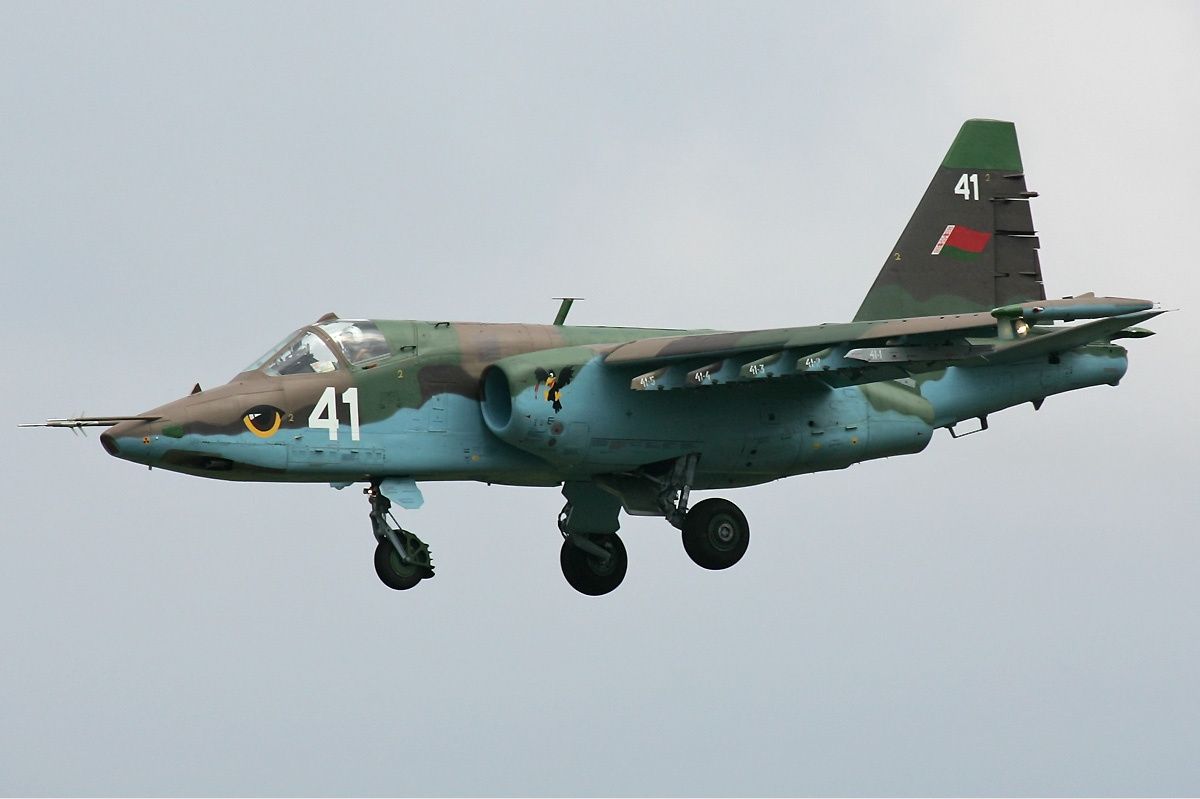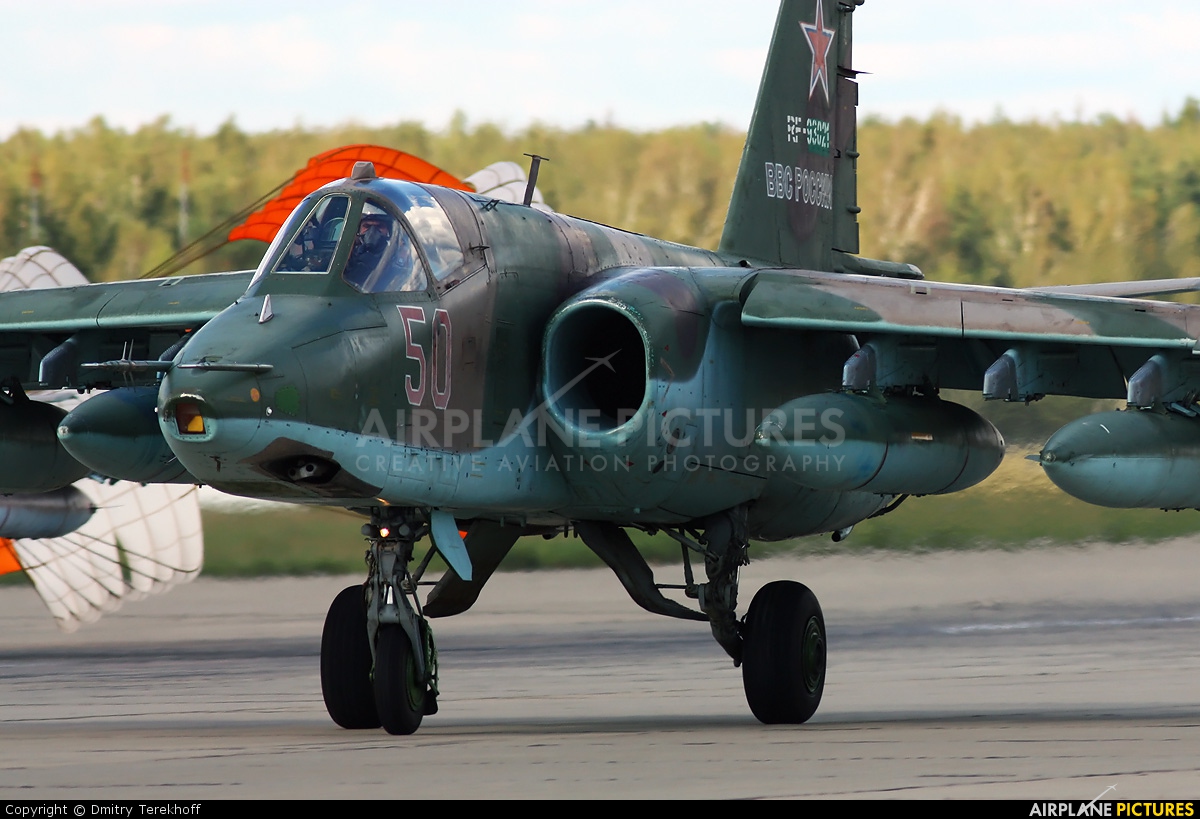Su 25 Sm - In total, the Sukhoi Su-25 accumulated a total of 60,000 sorties throughout its service in Afghanistan until its withdrawal by the Soviets in February 1989. The first Su-25 fighter unit created was based on the 200th Independent Attack Squadron ( OShAE). Sital-chai in Soviet Azerbaijan. The unit's first aircraft arrived in Afghanistan in May 1980, and in June the full unit was deployed to Shindand airfield in the western part of the country. The deployment was called an Operational Test and involved a team of engineers and technicians monitoring the aircraft and evaluating its performance. The first Su-25 combat operations began on 25 July with the 200th OShAE counterinsurgency and close air support sortie in support of the 5th Motorized Rifle Division. By 1982, the Su-25's area of responsibility had expanded and the aircraft began flying sometimes as far as Kabul, with pilots averaging 4-5, sometimes 8, sorties per day. The aircraft usually flew with external fuel tanks to increase its range, but was restricted from flying in bad weather or at night due to faulty navigation equipment. By the time the squadron left Afghanistan in October 1982, its Su-25s had flown over 2,000 sorties without loss, although some were damaged by ground fire. The deployment allowed engineers to make several changes to the aircraft's weapon systems, replacing them with ones more suitable for mountain operations and installing increased countermeasures and defensive systems.
The introduction of the Su-25 into Afghanistan resulted in a greatly expanded field of operations for Soviet ground commanders, who could now insert their troops deep into guerrilla territory with better air defense. As the war progressed, the Mujahideen came to fear and respect the Su-25, adapting their tactics around the assumption of its use.
Su 25 Sm

Su-25s were used as development platforms for Soviet precision-guided munitions, often being some of the first Soviet aircraft to use such munitions in combat against raids or weapons emplacements. In April 1986, the Su-25 used precision-guided munitions for the first time in combat, firing Kh-25 and Kh-29 missiles against Emy targets. The introduction of precision bombs and missiles allowed the Su-25 to begin flying missions at high altitudes, reducing the risk posed by anti-aircraft artillery and shoulder-launched surface-to-air missiles.
The Pilot Of The Su 25 Attack Aircraft Landed The Plane At The Home Airfield After Being Hit By A Rocket From A Manpads
Because the Su-25s were mostly tasked with flying low-altitude, subsonic, close air support missions in support of ground forces in combat, they made frequent targets for mujahideen anti-aircraft fire and surface-to-air missiles. Some 23 aircraft were shot down during the war, an additional dozen were lost in non-combat incidents, while another dozen were destroyed due to extensive damage, and a further nine aircraft were destroyed by ground bombing. in Kabul and Kandahar. Overall, Su-25s accounted for a quarter of the Soviet Air Force's (VVS) fixed-wing losses in operations.
On 16 January 1984, an Su-25 piloted by a Soviet lieutenant colonel was hit by a 9K32 Strela-2 missile and shot down near Urgun, Afghanistan, the first downing of an Su-25 in combat.
In August 1988, an Su-25 piloted by Colonel Alexander Rutskoi was hit by anti-aircraft fire and crashed. Rutskoi was expelled but landed on Pakistani soil and was later returned to the Soviets. Some sources say it was shot down by Pakistani warplanes.
In October of that year, an Su-25 suffered a heavy hit at high altitude north of Gardez, leaving it badly damaged but able to fly. The attack was reportedly the result of a missile fired by a Pakistani fighter jet.
Russians Demonstrated Their Su 25 Being Downed In Ukraine
In January 1989, a missile shot down an Su-25 near Kabul, killing the pilot in the aircraft's last combat loss in Afghanistan.
The Iraqi Air Force was the first non-Eastern country to receive the Su-25, Iraq received 69 single-seat "K" variants and four two-seat "UBK" variants between 1986 and 1987, enough to equip two squadrons ground attack. The Su-25 was used extensively in the later stages of the Iran-Iraq War, its first action outside Afghanistan in combat against Iranian forces. An Su-25K intentionally survives a direct hit from an Iranian MIM-23 Hawk surface-to-air missile battery, managing to return to base and land. In total, the Su-25 participated in more than 900 sorties in the conflict, and many of their pilots were personally decorated by Saddam Hussein.
Two Su-25Ks were lost in combat, one of which was lost to Iranian air defenses.

The Iraqi Air Force Su-25 aircraft played a minor role in the Persian Gulf War, as did most Iraqi aircraft. At least one Su-25 squadron saw action during the invasion of Kuwait in August 1990. During the war, IAF Su-25 aircraft were flown to neighboring Iran to defend against air attacks.
Su 25sm Grey
Two Su-25s were flown by the US. Shot down by F-15C interceptors on 6 February 1991 using AIM-9 Sidewinder air-to-air missiles.
However, most of Iraq's Su-25 fleet was destroyed on the ground in precision strikes on hardened air defenses during the war and could not be used for ground attacks against coalition forces.
During the Angolan Civil War, the Angolan Air Force used Su-25s against UNITA forces advancing on Luanda, but to little tactical effect as they flew bombing missions from high altitudes, reducing the aircraft's effectiveness, a problem exacerbated by the withdrawal of support Soviet. In 1991, this led to service problems.
In the early 1990s, the Su-25 was flown by the Mercury of the South African private military company Executive Outcomes, based at Sourimo Airport, against UNITA forces.
Su 25 Vs A 10: Here's Why The Frogfoot Might Be Better Suited Than The Warthog For Cas
During the war in Abkhazia, the Su-25 was used by the Georgian Air Force, the Abkhaz Air Force and the Russian Air Force in a number of combat operations in the separatist region. The Georgian Air Force flew 215 combat missions on the Su-25 during the war.
Russian Su-25s flying on the side of Abkhaz separatists have carried out several attacks on Georgian positions near the besieged port city of Sukhumi, flying from the Gudauța air base.
On at least one occasion, a Russian Su-25 bombed a residential neighborhood in Sukhumi, killing a civilian and destroying several houses and other buildings.

During the conflict, the Russian government claimed that the Su-25s bombing Georgian positions were not Russian, but in fact Georgian warplanes with colored Russian insignia, a claim that raised even more suspicion because these Su-25 they were flying unrestricted through Russian airspace. .
Russian Su 25 Jet Shot Down By Paratroopers, Ukrainian Brigade Says
On 6 January 1993, a Georgian Su-25 crashed in Abkhazia province, the pilot ejecting safely. On 19 March 1993, a Russian Air Force Su-25 piloted by Major Vazlav Shipko was shot down by the Georgian Air Defense Forces near Sukhumi, although some sources claim it was flying an Su-27. On 4 July 1993, a Georgian Su-25 was hit by an Abkhazian surface-to-air missile, forcing the aircraft into the sea near Sukhumi and killing the pilot.
The Ethiopian Air Force operated the Su-25 during the Eritrean-Ethiopian War after receiving a delivery of a pair of Su-25Ts and two Su-25UBKs from the Russian Air Force in March 2000. Combat operations by Mekele and Debre Zeit
On 15 May 2000, an Su-25 piloted by Flight Lieutenant Wondu Ghda was shot down by an Eritrean Air Force MiG-29, killing the pilot.
At least three Su-25s operated by Azerbaijan were shot down during the conflict. One was shot down by a missile in 1992 while on a ground attack mission over Armenian territory.
Rf 93881 Russian Federation Air Force Sukhoi Su 25sm Photo By Andrei Shmatko
In 1994, the two disappeared in separate incidents. In February, a plane was hit by ground fire, causing the pilot to eject and be captured. Another Su-25 was lost the following April, with the pilot ejecting.
A 1994 Human Rights Watch report accused Azerbaijan of indiscriminately using its Su-25 aircraft against civilian populations in Nagorno-Karabakh and Armia.
Su-25s were heavily used by the Russian Air Force again during the First and Second Czech Wars. During the First Chechen War, approximately 140 Su-25 aircraft carried out 5,300 attacks, notably playing a key role in the destruction and capture of the Grozny Presidential Palace by dropping BETAB-500 anti-concrete bombs.

However, Russian Su-25s rarely operate at night or in bad weather due to inadequate equipment and training, and the aircraft rarely use precision munitions, using bombs and unguided missiles for the most part.
File:sukhoi Su 25sm Frogfoot 06 Red (8584622490).jpg
This lack of precision munitions and poor training led to several rapid fire incidents in which Russian aircraft crashed into buildings occupied by Russian forces. However, Russian air losses during the campaign were minimal due to the lack of effective anti-aircraft defenses. Four Su-25s were lost in combat.
During the initial push into Chechnya, Russian Su-25 and Su-24 strike aircraft destroyed most of the dilapidated Chechen air force on the ground within hours. In 1995, air cover provided by the Su-25 in clear weather allowed Russian troops to push across the Argun River to the towns of Gudermes and Shali, setting the stage for a decisive victory against separatist forces in the region.
Czech separatist leader Dzhokhar Dudayev was assassinated on April 21, 1996.
1 48 su 25, icom sm 25, 25 sm, sm-25, su 25, su-25 frogfoot, sukhoi su 25 frogfoot, sm 42byg011 25, su 25 model, su-25, su 25 model kit, su sm
0 Comments